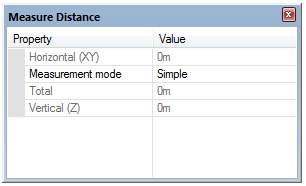 (100).gif) Measure Distance
Measure Distance (100).gif) Measure Distance
Measure Distance
.gif) Measure Distance measures and reports the distance between positions, or alternatively the cumulative distance from one position, through a series of subsequent positions, to the last position chosen. The positions can be three-dimensional.
Measure Distance measures and reports the distance between positions, or alternatively the cumulative distance from one position, through a series of subsequent positions, to the last position chosen. The positions can be three-dimensional.
Select .gif) Measure Distance, the Measure Distance dialog will be displayed:
Measure Distance, the Measure Distance dialog will be displayed:

The Horizontal (XY) and Vertical (Z) fields give a constant read-out of distances from the first point to the subsequent points. The horizontal distance is the direct distance between the points on the XY plane. The vertical distance is the Z height.
When you click the point(s) to measure to, the distance between them is given as a running total in the Total field.
All distance values are reported in the current units and and to the number of decimal places settings as set by CRS [Home-Map], Coordinate Reference Systems dialog, Units tab.
There are three Measurement modes to choose from when using Measure Distance:
Press Enter or double-click to finish the Measure Distance command.

An  Information box will be displayed showing the distance, the units and number of decimal places are as set in the Coordinate Reference Systems dialog. To change the units or number of decimal places go to CRS [Home-Map], Units tab.
Information box will be displayed showing the distance, the units and number of decimal places are as set in the Coordinate Reference Systems dialog. To change the units or number of decimal places go to CRS [Home-Map], Units tab.
Click the Copy to clipboard button to copy the value to the Windows clipboard as text. When pasted back, it is placed as a text item at the centre of the current map window, or it can be pasted into a text dialog box or a spreadsheet, as appropriate.
Click the x button in the  Information box to dismiss the message.
Information box to dismiss the message.
If the current Coordinate Reference System is spherical (i.e. Latitude/Longitude), then Great Circle distances are measured. The Great Circle distance is calculated accurately in radians using the haversine expression. The angular distance is then converted to metres using an approximation for the local radius of curvature of the Earth.
If the current Coordinate Reference System is Cartesian, then the 3D straight line distance is measured. If the Coordinate Reference System is Transverse Mercator, then the measuring is done within the Coordinate Reference System, so the answer will not take account of the Coordinate Reference System distortions.
Top of page
Send comments on this topic.
Click to return to www.cadcorp.com
© Copyright 2000-2017 Computer Aided Development Corporation Limited (Cadcorp).